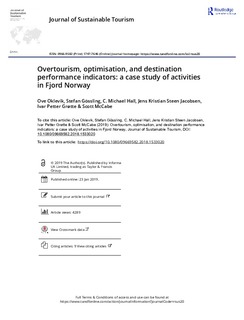| dc.contributor.author | Oklevik, Ove | |
| dc.contributor.author | Gössling, Stefan | |
| dc.contributor.author | Hall, C. Michael | |
| dc.contributor.author | Jacobsen, Jens Kristian Steen | |
| dc.contributor.author | Grøtte, Ivar Petter | |
| dc.contributor.author | McCabe, Scott | |
| dc.coverage.spatial | Norway | nb_NO |
| dc.date.accessioned | 2019-08-06T08:53:05Z | |
| dc.date.available | 2019-08-06T08:53:05Z | |
| dc.date.created | 2019-01-23T14:51:13Z | |
| dc.date.issued | 2019 | |
| dc.identifier.citation | Oklevik, O., Gössling, S., Hall, C. M., Steen Jacobsen, J. K., Grøtte, I. P., & McCabe, S. (2019). Overtourism, optimisation, and destination performance indicators: a case study of activities in Fjord Norway. Journal of Sustainable Tourism, 1-21. | nb_NO |
| dc.identifier.issn | 0966-9582 | |
| dc.identifier.uri | http://hdl.handle.net/11250/2607254 | |
| dc.description.abstract | Many global tourist destinations have experienced growth in arrivals. This has triggered various conflicts in destinations and sparked debates as to how to deal with what is increasingly referred to as ‘overtourism’. Most destination marketing organisations (DMOs) pursue strategies to stimulate arrivals even further. Pro-growth discourses are reinforced by lead bodies such as the World Tourism Organisation (UNWTO). However, maximisation strategies based on higher numbers of tourists increasingly cause conflicts with local residents, whereas simultaneously undermining climate change mitigation pledges as negotiated in the Paris Agreement. New approaches to destination management based on optimisation are therefore warranted. Drawing on a survey of international tourists (N=5249) in south-western Norway, this article discusses whether ‘activities’, i.e. the development of local, small-scale and ideally more sustainable experiences, can contribute to economic growth without necessarily increasing numbers of arrivals. Results confirm that destinations should seek to better understand their markets, including length of stay, spending, and/or activity intention, to identify profitable markets. Ultimately, such knowledge may help addressing overtourism conflicts while building tourism systems that are more economically, socially, and environmentally resilient. | nb_NO |
| dc.language.iso | eng | nb_NO |
| dc.publisher | Taylor & Francis | nb_NO |
| dc.relation.uri | https://www.tandfonline.com/doi/full/10.1080/09669582.2018.1533020 | |
| dc.rights | Attribution-NonCommercial-NoDerivatives 4.0 Internasjonal | * |
| dc.rights.uri | http://creativecommons.org/licenses/by-nc-nd/4.0/deed.no | * |
| dc.subject | Over-turisme | nb_NO |
| dc.subject | Overtourism | nb_NO |
| dc.subject | Destinasjonsutvikling | nb_NO |
| dc.subject | Destination development | nb_NO |
| dc.title | Overtourism, optimisation, and destination performance indicators: a case study of activities in Fjord Norway | nb_NO |
| dc.type | Journal article | nb_NO |
| dc.type | Peer reviewed | nb_NO |
| dc.description.version | publishedVersion | nb_NO |
| dc.rights.holder | © 2019 The Author(s). | nb_NO |
| dc.subject.nsi | VDP::Samfunnsvitenskap: 200 | nb_NO |
| dc.subject.nsi | VDP::Social sciences: 200 | nb_NO |
| dc.source.pagenumber | 21 | nb_NO |
| dc.source.journal | Journal of Sustainable Tourism | nb_NO |
| dc.identifier.doi | 10.1080/09669582.2018.1533020 | |
| dc.identifier.cristin | 1663837 | |
| dc.relation.project | Transportøkonomisk institutt: 4031 | nb_NO |
| cristin.unitcode | 203,13,3,0 | |
| cristin.unitname | Institutt for økonomi og administrasjon | |
| cristin.ispublished | true | |
| cristin.fulltext | original | |
| cristin.qualitycode | 1 | |

